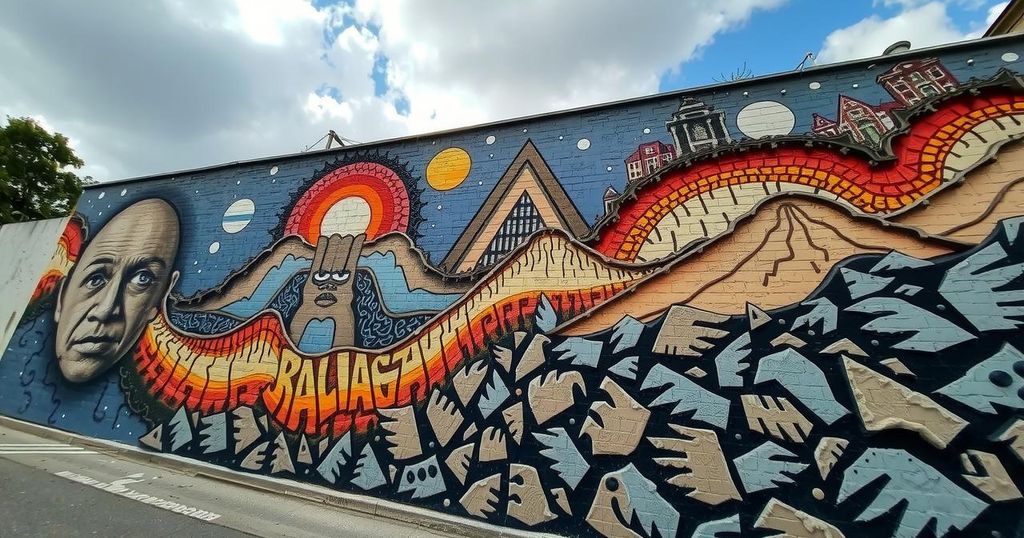Brazilian artist Mundano has created a significant mural in Sao Paulo using ash from wildfires and mud from floods to raise awareness about climate disasters and deforestation in the Amazon. Emphasizing corporate accountability, he specifically targets the soy industry, urging Cargill to uphold its deforestation commitments. The project reflects broader environmental crises, including severe droughts and floods, and highlights the critical need for sustainable practices.
Brazilian artist Mundano has unveiled a monumental mural in Sao Paulo that poignantly portrays the devastating impact of climate change through the incorporation of ash from wildfires and mud from floods. Measuring over 30 meters (98.4 feet) in height and 48 meters (157.5 feet) in width, this striking artwork vividly illustrates the themes of deforestation and severe drought affecting the Amazon rainforest, showcasing its barren earth and gray tree stumps. The mural features Indigenous activist Alessandra Korap adorned with a floral crown, holding a placard that pleads: “Stop the destruction keepyourpromise.” This message directs accountability towards Cargill, a soy corporation based in Minnesota, as soy farming significantly contributes to Amazon deforestation. Mundano aims to ensure Cargill adheres to its commitment to eliminate deforestation from its supply chain in Brazil, Argentina, and Uruguay by the year 2025. He proclaimed, “We are tired of being a country, a continent where we and the natural resources we have here are exploited. … We have to regenerate our planet instead of destroying it.” The recent months have witnessed widespread destruction caused by human-induced wildfires, ravaging crucial ecosystems such as the Amazon, Cerrado savanna, and Pantanal wetland. Reports indicate that smoke from these fires has severely affected urban air quality across many regions. Concurrently, Brazil is grappling with ongoing drought conditions, which are expected to continue, exacerbating the existing crisis. Data reveal that the Negro River in the Amazon has reached alarmingly low levels, marking a notable decline in water depth compared to historical averages. This unprecedented dry season has also led to catastrophic flooding in earlier months, which tragically resulted in the loss of over 180 lives in Rio Grande do Sul and impacted over two million individuals. In crafting this mural, Mundano utilized mud from the recent floods, collected with aid from the Movement of People Affected by Dams, alongside ash sourced from various Brazilian ecosystems. He also incorporated discarded soil from Sao Paulo and clay from the Sawre Muybu Indigenous land, reinforcing the interconnectedness of environmental crises and the impact of human activity on nature. Previously, Mundano created a mural reflecting climate-related themes, which used ash from the Amazon to depict the struggles against deforestation and fire in 2020. With this latest endeavor, he emphasizes the imperative of recognizing the stark realities of climate change and the role art can play as a medium for activism and awareness.
The mural by Mundano draws attention to the ongoing environmental crises in Brazil, particularly in the Amazon rainforest, which have been exacerbated by climate change and industrial activities. Climate change, primarily driven by fossil fuel consumption, is causing more extreme weather events, including droughts and floods, which in turn threaten biodiversity and Indigenous communities. The soy industry, led by major corporations like Cargill, plays a significant role in deforestation, prompting calls for corporate responsibility and sustainable practices. The context of Mundano’s work highlights both the urgent need for climate action and the power of art to foster awareness and provoke change.
Mundano’s mural serves as a powerful critique of the ongoing environmental degradation driven by industrial practices and climate neglect. By using materials that symbolize destruction and loss, he underscores the interconnectedness of climate issues affecting Brazil and advocates for accountability from corporate entities. The artist’s appeal to regenerate rather than exploit the planet resonates deeply in the current climate crisis, emphasizing a collective responsibility for environmental stewardship.
Original Source: abcnews.go.com






